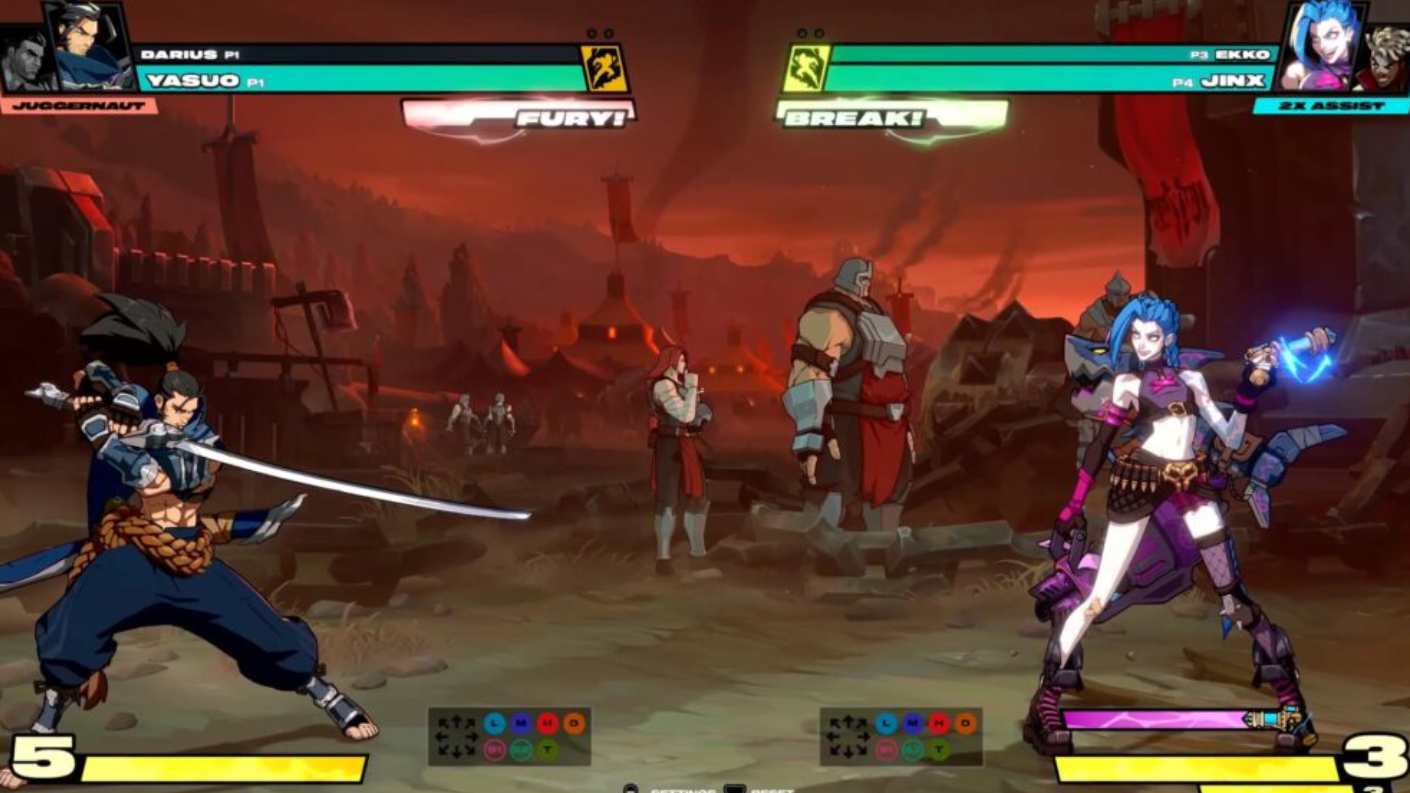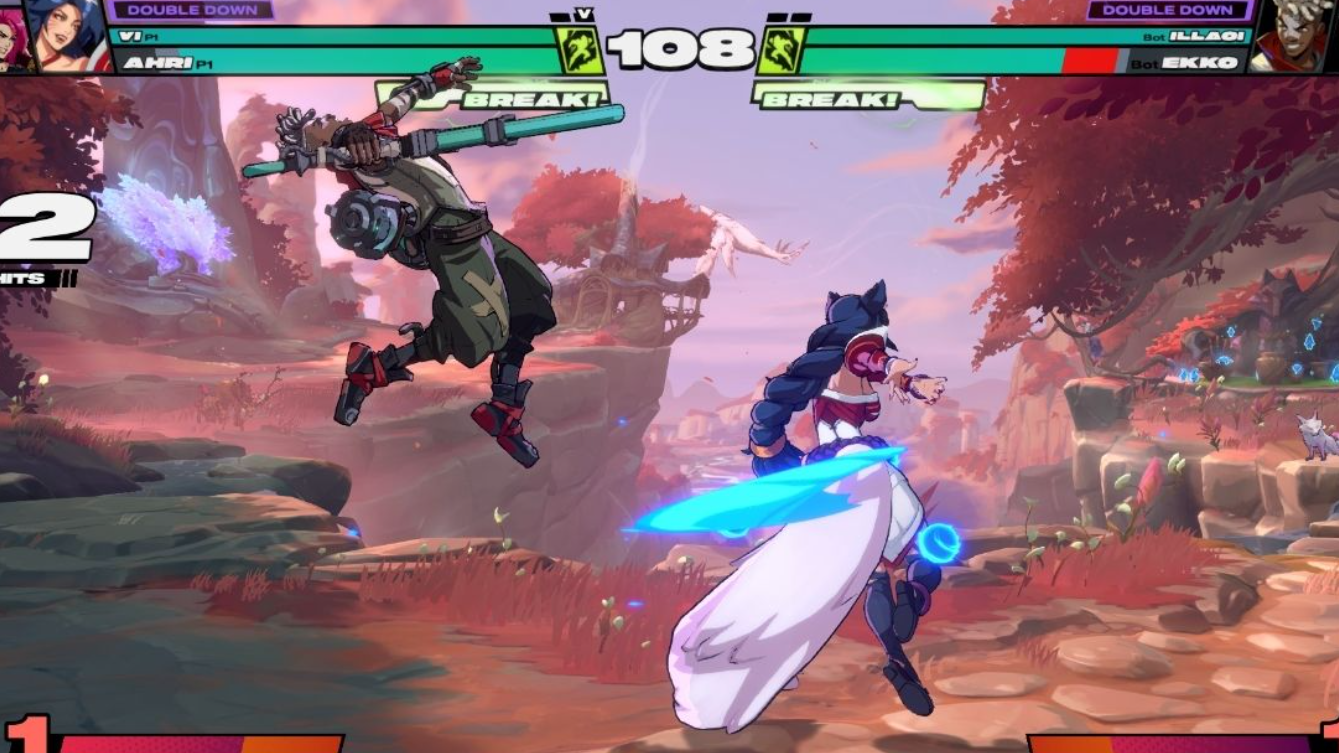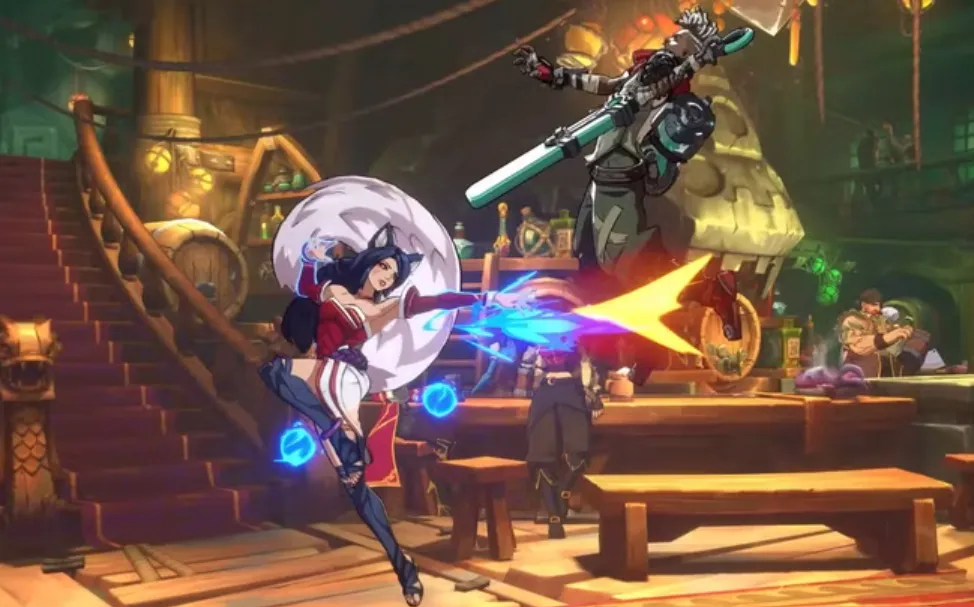2XKO control scheme (no motion inputs)
2XKO drops traditional quarter-circles, dragon punches, and charge motions in favor of a universal layout built around three attack buttons—Light, Medium, and Heavy—and two dedicated special buttons, S1 and S2. Directional input modifies both normals and specials. That means you’re rarely rolling the stick; you’re pressing a direction plus a button, sometimes with a short hold or a two-button chord for certain actions.
In practice, it feels closer to a “universal controls” brawler than a classic motion fighter. You’ll get different attacks off neutral, forward, down, up, and diagonals, and many characters layer extra effects on long-press or while airborne. Tag actions also key off directions, so the left hand stays busy even without motions.
2XKO universal inputs and combo examples
While the specifics of specials vary per character, several inputs and behaviors are shared across the roster today. These map cleanly and are worth memorizing first.
| Input | Function | Notes |
|---|---|---|
| Down + forward + Heavy | Universal launcher | Routes into air combos for all characters |
| Down + Heavy | Anti-air | Grounded option to contest jumps above |
| (Airborne) Down + Heavy | Cross-up jump attack | Hits behind the opponent |
| Down-down + S1 or S2 | Level 1 Ultimate | Consumes 1 meter bar |
| Down-down + S1 + S2 | Level 2 Ultimate | Consumes 2 meter bars, cinematic |
| Assist + forward/back | Directional tag assist | Direction modifies assist behavior |
There’s also a simple launch route that works across the cast:
L → M → H → Launcher (↓↘ + H) → jump → L → M → H → Special (S1 or S2)
Special move buttons S1 and S2 (directional specials, no motions)
All specials live on S1 and S2, modified by directions. Think of them as two “special families” per character, each with multiple directional branches. The benefit is mechanical: executing a special is as simple as pressing a direction plus S1 or S2—no quarter-circle timing required.
The trade-off is organizational. There isn’t a single global rule that always separates “what belongs on S1” versus “what belongs on S2” across the full roster. You can’t rely on old motion-game heuristics (projectile on quarter-circle-forward, anti-air on dragon punch motion) to infer a move’s location. You will need to learn each character’s mapping: which directions invoke which S1 or S2 special, which branches have follow-ups or stance variations, and which ones accept holds.
What removing motions actually simplifies
- Lower execution barrier for specials: A directional tap plus S1/S2 is easier to perform reliably under pressure than multi-step motions.
- More consistent conversions: The universal launcher and air routes give every character a baseline combo path you can build on.
- Clear anti-air and cross-up options: Down + Heavy on the ground and in the air anchor basic vertical control without motion inputs.
If you’ve bounced off motion execution in other fighters, this setup smooths the first hurdle—getting your specials out, on time, every time.

What this control scheme complicates
- Memorization over intuition: Without motion patterns to guide you, S1/S2 assignments must be learned move-by-move.
- Input variety still matters: Expect holds, double taps, and two-button chords (like S1+S2) alongside directional presses.
- System density: Between tag options and universal mechanics layered onto directions, the total number of interactions remains high.
This is why players coming from motion-heavy games can feel disoriented at first. The physical execution is simpler, but the mental model shifts from “recognize the motion” to “recall the branch.”

How to learn a 2XKO character quickly
Approach each character in passes, anchoring to the universal pieces first and then filling in S1/S2 branches.
- Pass 1 — Core combat: Drill Light/Medium/Heavy chains into universal launcher, then the air route. Confirm that Down + Heavy anti-air and airborne Down + Heavy cross-up do what you expect at different spacings.
- Pass 2 — S1/S2 map: In training, walk through neutral, forward, down, up, and down-forward on S1 and S2. Note which directions accept holds and what changes. Write a one-line purpose for each (e.g., “S1 forward: approach tool,” “S2 down: reversal/defense”).
- Pass 3 — Meter and finishers: Practice Down-down + S1/S2 for Level 1 and Down-down + S1+S2 for Level 2 from both raw neutral and inside combos. Focus on spacing and cancel points where these actually land.
- Pass 4 — Tag layers: Add forward/back variations to assists and test how they cover your character’s gaps—anti-air coverage, approach safety, or corner carry.

Translating motion-game instincts
Traditional motion inputs carry decades of tacit “genre language”: quarter-circle-forward often means projectile; dragon punch means invincible anti-air; half-circle can imply a command grab. In 2XKO, that language doesn’t exist. Build a replacement vocabulary per character:
- “Space control” special: The S1/S2 direction that checks movement or wins neutral trades.
- “Vertical escape or denial” special: The branch that covers jump arcs or grants vertical mobility.
- “Close-range check” special: The fast button-direction pair you can safely press in scrambles.
- “Meter threat” routes: The confirms that reliably reach Level 1 or Level 2 Ultimates.
Once you’ve labeled those roles, the lack of motions stops being a barrier; it becomes a faster menu you can access under pressure.
Why veterans still feel friction
Even experienced players can stumble here for two reasons. First, 2XKO’s two-special-button model adds breadth: S1 and S2 each carry multiple directional branches per character, with some overlap in function. Second, the button layout and tag mechanics introduce a lot to remember early on. Until your hands internalize which branch lives where—and how assist directions alter coverage—your inputs may feel “right” yet call the “wrong” special. That sensation fades with dedicated mapping work in training, but it’s real during the first hours.
What to practice (and what to ignore early)
- Lock in the universal: launcher route, anti-air, cross-up, and the two Ultimate inputs. Those four pillars stabilize your rounds.
- Pick two specials per button: Choose the most practical S1/S2 directions for neutral and pressure. Add more only after those are consistent.
- Delay the niche: Save stance-only follow-ups, long-hold variants, or corner-only routes until your base kit is automatic.
By constraining your early palette, you turn a wide control surface into a tight game plan. You can always layer complexity back in.

Key takeaway
2XKO’s no-motion inputs succeed at reducing execution tax on specials and codifying a few strong universal actions. The cost is a cognitive one: you’ll trade familiar motion patterns for per-character S1/S2 maps and a dense set of directional branches. If you learn it in passes—universal first, then a curated S1/S2 set, then meter and tags—the scheme becomes fast, dependable, and legible under pressure, even without a single quarter-circle.


